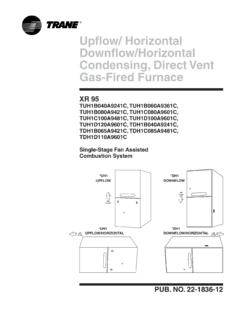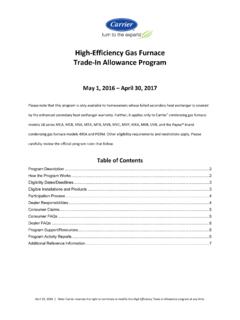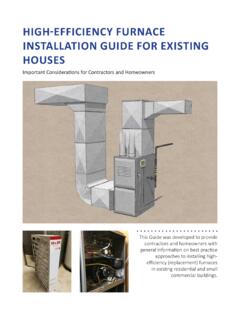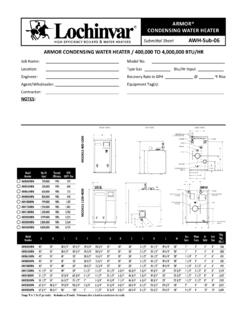Transcription of Condensing vs. Non-Condensing - Energy
1 WELCOMEC ondensing vs. Non-CondensingGas AppliancesGas Non- Condensing Furnace Burners are ignited Blower motor is turned on Cool or return air enters, is filtered and blown through furnace heat exchanger Heat from the combustion chamber goes through the heat exchanger Air absorbs heat and is passed out through supply duct Exhaust gasses are vented out through type B vent to roof Non- Condensing Furnace Installation Requires type B metal vent up to and through the roof Requires indoor combustion air Should have minimal professional maintenance Minimum 80% efficientGas Condensing Furnace Second heat exchanger used to heat the air from condensed exhaust gasses Less expensive venting (Usually PVC)
2 On new constructionCondensing Furnace Installation Requires PVC venting Will not connect to existing venting when replacing existing furnace Most models are direct vent (does not require indoor combustion air) Can require annual professional maintenance Minimum 90% efficientOrphaned Water Heater Many homes utilize a combination venting system through a chimney where the WH & Furnace share a vent. In existing homes where an older non- Condensing Furnace is replaced by a 90+ efficiency appliance, an Orphaned Water Heater can occur. When the new Condensing furnace is vented directly outside, the remaining vent for the WH is drastically oversized and serious CO concerns may arise.
3 Methods to address this problem can be a major financial Water HeaterConnected to oversized flueLiner installed through flueGas Non- Condensing Water Heaters Cold water enters through the inlet and is released at the bottom The gas burner heats the water Warm water rises and exits through the outlet pipe Exhaust from burner exits through a baffled flue and is vented outside (type B vent)Standard Storage-Type Water Heater Installation Requires 6 of clearance for type B ventilation 4 -6 sq ft ground space Requires indoor combustion air Seamless installation when replacing existing water heater (reconnect to existing structures) Should be flushed by homeowner annually Requires very little other maintenance Gas Condensing Water Heater Hot exhaust gases are captured and utilized to heat the water in addition to main burner Less expensive venting in new construction Cannot connect to existing venting when replacing old WH More Efficient Low NOx (Nitrogen Oxides)
4 EmissionCondensing Water Heater Installation Requires PVC venting, no clearance to combustibles (some models may be direct vent) 4 -6 sq ft ground space Requires new venting when replacing existing water heater May not require indoor combustion air Annual professional maintenance recommendedMID- efficiency VS. high -EFFICIENCYAFUE(AnnualFuelUtilizatio n efficiency )VENTINGBASICOPERATIONENHANCEM ENTSPROSCONS80-83 Mid efficiency Traditional metallic pipingand/or chimney liner Utilizeexisting venting onremodel/upgrade Fan-assisted draft Should be through roof Electronic Ignition Faninduced Draft Small Diameter Flue Severalfan/burner controls Retrofits are simple Less expensive Less maintenance Proven/familiardesigns Cannot be direct vent Consume more fuel Produce more byproducts90+ high efficiency Must be vented accordingto manufacturer sinstructions.
5 Most likely require PVC Can be direct-vent or fan-assisted draft Can be through wall Sealed Combustionchamber Utilize second heatexchanger to extractheat from flue gas Lower temp flue gas Condensing Many fan/burner controls Consume less fuel Produce lessunwanted byproducts Easier install on newconstruction More expensive More maintenance Newer designsnotas well proven More parts to break Condensate disposal Retrofits arecomplex Orphaned WHTHANKYOU

















